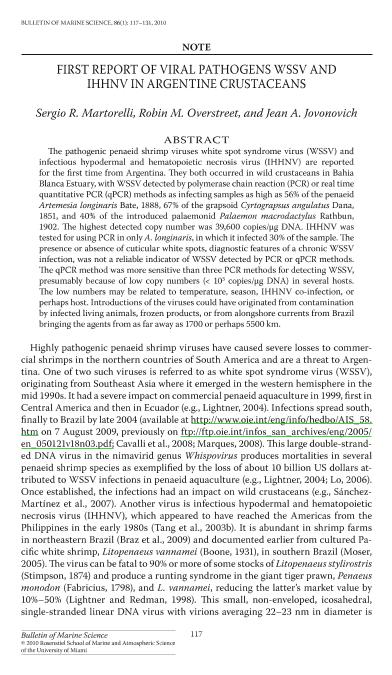Artículo
First Report of viral Pathogens WSSV and IHHNV in Argentine Crustaceans
Fecha de publicación:
01/2010
Editorial:
Rosenstiel School of Marine and Atmospheric Science
Revista:
Bulletin of Marine Science
ISSN:
0007-4977
Idioma:
Inglés
Tipo de recurso:
Artículo publicado
Clasificación temática:
Resumen
The pathogenic penaeid shrimp viruses white spot syndrome virus (wSSv) and infectious hypodermal and hematopoietic necrosis virus (IhhNv) are reported for the first time from Argentina. They both occurred in wild crustaceans in Bahia Blanca Estuary, with wSSv detected by polymerase chain reaction (pCR) or real time quantitative pCR (qpCR) methods as infecting samples as high as 56% of the penaeid Artemesia longinaris Bate, 1888, 67% of the grapsoid Cyrtograpsus angulatus dana, 1851, and 40% of the introduced palaemonid Palaemon macrodactylus Rathbun, 1902. The highest detected copy number was 39,600 copies/μg dNA. IhhNv was tested for using pCR in only A. longinaris, in which it infected 30% of the sample. The presence or absence of cuticular white spots, diagnostic features of a chronic wSSv infection, was not a reliable indicator of wSSv detected by pCR or qpCR methods. The qpCR method was more sensitive than three pCR methods for detecting wSSv, presumably because of low copy numbers (< 103 copies/μg dNA) in several hosts. The low numbers may be related to temperature, season, IhhNv co-infection, or perhaps host. Introductions of the viruses could have originated from contamination by infected living animals, frozen products, or from alongshore currents from Brazil bringing the agents from as far away as 1700 or perhaps 5500 km.
Palabras clave:
VIRUS
,
CRUSTACEAN PATHOGENS
,
WSSV
,
IHHNV
Archivos asociados
Licencia
Identificadores
Colecciones
Articulos(CEPAVE)
Articulos de CENTRO DE EST.PARASITOL.Y DE VECTORES (I)
Articulos de CENTRO DE EST.PARASITOL.Y DE VECTORES (I)
Citación
Martorelli, Sergio Roberto; Overstreet, Robin M.; Jovonovich, Jean A.; First Report of viral Pathogens WSSV and IHHNV in Argentine Crustaceans; Rosenstiel School of Marine and Atmospheric Science; Bulletin of Marine Science; 86; 1; 1-2010; 117-131
Compartir




